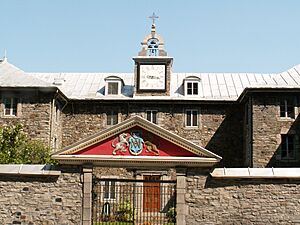Society of the Priests of Saint Sulpice facts for kids
|
Compagnie des Prêtres de Saint-Sulpice (French)
|
|
 |
|
| Abbreviation | Post-nominal letters: P.S.S. |
|---|---|
| Nickname | Sulpicians |
| Formation | 1642 |
| Founder | Fr. Jean-Jacques Olier, PSS |
| Founded at | Paris, France |
| Type | Society of apostolic life of Pontifical Right for men |
| Headquarters | General Motherhouse 6, rue du Regard, 75006 Paris, France |
|
Membership
|
243 members (243 priests) as of 2020 |
|
Motto
|
Latin: Auspice Maria English: Under the guidance of Mary |
|
Superior General
|
Fr. Shayne Craig, PSS |
|
Ministry
|
Education of seminarians and priests |
|
Countries served
|
France, Canada, and the United States. |
|
Parent organization
|
Roman Catholic Church |
| Website | www.generalsaintsulpice.org/en/ |
The Society of Priests of Saint-Sulpice, also known as the Sulpicians, is a group of Catholic priests. They are named after the Church of Saint-Sulpice, Paris, where their group began. Members add the letters PSS after their names.
Sulpicians focus mainly on educating future priests. They also do some parish work. They believe in always learning and growing spiritually. The Society works in three main areas: France, Canada, and the United States.
Contents
The Sulpicians in France
The Society of Priests of Saint-Sulpice started in France in 1641. It was founded by Father Jean-Jacques Olier (1608–1657). He was a follower of the French School of Spirituality.
At that time, many French priests needed better training. Father Olier wanted to improve how priests were prepared. He gathered some priests and students in Paris in 1641. Soon after, he moved his group to the Saint-Sulpice parish. This is how the Society got its name.
He built a seminary, which is a school for priests, next to the Saint-Sulpice church. This was the first Sulpician seminary. Students there received spiritual training. They took most of their theology classes at the Sorbonne university. Many church leaders noticed this new seminary. Soon, Sulpicians were running other seminaries across France.
Sulpician priests helped their local church communities during the day. At night, they returned to their seminaries. They became known for improving church life and priest training. They also helped people grow in their faith.
In the 1700s, many young men, including sons of noble families, joined them. The Sulpician seminary in Paris closed during the French Revolution. Its teachers and students had to scatter to stay safe. After the Revolution, the Sulpicians continued their teaching mission. Their seminaries became known for strong academics and high moral standards. The Society then spread from France to Canada, the United States, and other countries. This included Vietnam and parts of Africa.
The Sulpicians in Canada
Early Days in New France

The Sulpicians played a big part in starting the Canadian city of Montreal. They worked as missionaries and trained priests. They also built the Saint-Sulpice Seminary there.
A group called the Société Notre-Dame de Montréal received land in Montreal. Father Olier was a founder of this group. Their goal was to teach the native people about Christianity. They also wanted to build schools and hospitals for everyone. In 1657, Father Olier sent four Sulpician priests to Montreal. They formed the first church parish there.
In 1663, the Société Notre-Dame de Montréal gave its land to the Sulpicians. Just like in Paris, the Montreal Sulpicians had important jobs in the community. They acted as "seigneurs" for the island of Montreal. This meant they managed the land and its people.
The Sulpicians were missionaries, judges, and teachers. They helped build canals and plan cities. They were very involved in shaping early Montreal. Even with all their work, they returned to the Saint-Sulpice Seminary every night. The seminary was run by a superior and a council. The superior was like a father figure and was highly respected.
Missionary Work in Canada
In 1668, some Sulpicians went to teach native groups in different areas. These included the Haudenosaunee, Mi'kmaq, and Algonquins. François Dollier de Casson and Brehan de Gallinée explored the Great Lakes region in 1669. They even made a map of the area.
In 1676, the mission of La Montagne opened in Montreal. M. Belmont built a fort there in 1685. Later, this mission moved to a new location. In 1717, the Sulpicians received more land. In 1721, they moved the mission again. They created two villages on this new land. One village was for the Mohawks, called Kanesatake. The other was for the Algonquins and Nipissings.
After the British Conquest
In 1764, the Sulpicians in Paris gave all their Canadian property to the Montreal Sulpicians. This helped the Sulpicians in Canada continue their work. They became loyal to the British Crown. Other religious groups that were too tied to France had their properties taken.
After the French Revolution in 1794, twelve Sulpicians came to Montreal. They were escaping persecution in France. This helped the Sulpician community in Montreal grow.
In 1840, the British Crown officially recognized the Sulpicians' land. This allowed them to keep their property and continue their mission. The Lachine Canal opened in 1825. This helped Montreal connect to markets in the United States. It led to a big industrial area called Pointe-Saint-Charles. A large part of this area was once the Sulpicians' Saint-Gabriel Farm.
In 1840, the Sulpicians took over a theology school. They created the famous Grand Séminaire de Montréal. This school has trained many priests and bishops from Canada and the United States.
Today, Canadian Sulpicians work in seminaries in Montreal and Edmonton. Since 1972, they have also worked in Latin America. They have missions in Brazil and Colombia. They have also served in Fukuoka, Japan, since 1933.
In 2006, the Montreal Sulpicians created a non-profit group. This group works to save and share their old books, archives, and historical items. These collections show the history of education in Quebec. They include books from the 17th to the 20th century. In 2021, these collections were recognized as important cultural heritage in Quebec.
The Sulpicians in the United States
Sulpicians first arrived in what is now the United States in 1670. Fathers Dollier de Casson and Brehan de Galinee landed near what is now Detroit, Michigan. In 1684, Robert de la Salle led an expedition to Texas. Three Sulpician priests were with him. The ship was wrecked, but the priests survived. Two returned to France. Dollier de Casson stayed to teach the native people. He later moved to the successful Sulpician mission in Montreal.
In July 1791, four Sulpicians arrived from France. They started the first Catholic school for priests in the United States. It was called St. Mary's Seminary in Baltimore. They bought a building and dedicated it to the Blessed Virgin. In October, they started classes with five students. This began the first lasting Sulpician community in the country.
More priests arrived in 1792. Many of these early priests became missionaries. They went to distant areas of the United States. Flaget and David founded the Catholic Seminary of St. Thomas in Bardstown, Kentucky. This was the first seminary west of the Appalachian Mountains. Their St. Thomas Catholic Church, built in 1816, is the oldest brick church still standing in Kentucky. In 1796, Louis William Valentine Dubourg became the president of Georgetown University. He later became the first bishop of the Louisiana Territory.
Dubourg also helped Elizabeth Seton start the first American group of Catholic Sisters in 1809. The Sulpicians guided them until 1850. In 1829, Sulpician Fr. James Joubert worked with Mary Lange. They started the first community of Black Sisters in the United States, called the Oblate Sisters of Providence.
The Society helped start and staff other seminaries. These included St. John's Seminary in Boston and St. Joseph Seminary in New York.
In 1898, the Sulpicians founded Saint Patrick Seminary, Menlo Park in California. From the 1920s to 1971, they ran St. Edward Seminary in Kenmore, Washington. The land is now Saint Edward State Park and Bastyr University.
In 1917, the Sulpician Seminary began construction in Washington, D.C.. It became an independent school in 1924. In 1940, it changed its name to Theological College. Over 1,500 priests have graduated from there. This includes many bishops and cardinals.
American Sulpicians have been known for new ideas. They focused on personal spiritual guidance and teamwork in leadership. Since 1989, U.S. Sulpicians have worked with bishops in Zambia. As of 2014, they have several seminary programs there.
The American Province has also produced important scholars. One well-known scholar was Raymond E. Brown, who studied the Bible.
Sainthood Causes
Some Sulpicians are recognized for their holy lives.
Blesseds
- Bernard-François de Cucsac and 11 Companions (died 1792), martyrs of the French Revolution.
- Charles-René Collas du Bignon (died 1794), martyr of the French Revolution.
- Joseph Juge de Saint-Martin (died 1794), martyr of the French Revolution.
- Claude-Joseph Jouffret de Bonnefont (died 1794), martyr of the French Revolution.
Servants of God
- Jean-Jacques Olier (1608–1657), founder of the Society.
- Jacques-Martin Ploquin (1766–1794), martyr of the French Revolution.
Sulpicians Today
As of 2010, there were 293 Sulpician priests.
Notable Sulpicians
- Raymond E. Brown
- John Francis Cronin
- Étienne-Michel Faillon
- Joseph Martin
- Georges Morand
- Marc Ouellet
- Emmanuel Célestin Suhard
- Joseph Tixeront, a theologian from the late 1800s and early 1900s.
- François du Plessis de Grenédan (1921–2013), a chaplain during World War 2.
See also
- Collège de Montréal
- Consecrated life
- Institute of consecrated life
- Joseph Onasakenrat
- Religious institute (Catholic)
- Secular institute
- Vocational discernment in the Catholic Church
External links
- Church and organ of St-Sulpice: (in French and English)
- U.S. Province of the Society of Saint-Sulpice Official website
- Canadian Province of the Society of Saint-Sulpice Official website
la:Sulpitius Pius (episcopus Bituricensis)

